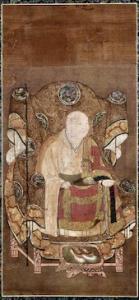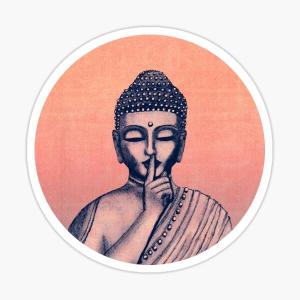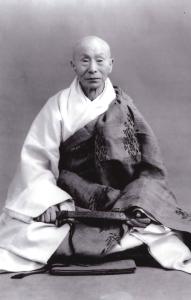 A couple weeks ago I posted “Zen is Going to Hell and It’s the Boomers’ Fault!”
A couple weeks ago I posted “Zen is Going to Hell and It’s the Boomers’ Fault!”
Today’s post is a follow up and in the blaming way of the moment, I’ll say it’s James Ford’s fault.
You see, I was all set to let the matter rest, but then this morning I read his lovely “the prayer of form and emptiness.”
As I’ve said before, James is a much nicer person than me and much more of a gentleman. He brings up an issue that I’ve been chewing on regarding the survey of Soto teachers that I mentioned in the above post but in oh-so-delicate-a way.
Writing about the importance of tasting the great empty, James says (that I’ll quote without his myriad paragraph breaks – sorry buddy),
“And it is important. More than words can convey. I think critical for those of us who wish to see what we are, who we can be, and where it might all take us. And so. Here we stand at the gate of liberation. But, and this is where many people get confused. This noticing of the one, or, as I prefer, with slightly less luggage, the great empty is necessary but not sufficient. Then, we need to continue on to the next realization (emphasis added).”
Although I agree, I like to emphasize a somewhat different angle. Becoming the great empty is so important in Soto Zen because it points out what is to be practiced in our practice-enlightenment way. Without a taste of vividly becoming who we already are, we are likely to go on just practicing delusion.
Or as Dogen says, “Hearing Zhaozhou’s Mu, the course of practice to be pursued opens up.”
This brings me to the survey and my present grounds for ongoing cursing and criticism of the present state of Soto Zen. I’m not exactly winning friends and influencing people, but I am saying what I think is important for Soto students and advocating for the Soto way that in my life has been enormously important and life-giving.
And, yes, I confess, it is fun for me to raise a little hell from time to time too.
Here’s the item in question – “Exhibit 2, your honored ones:”
“Is it sufficient for one’s teacher to recognize and acknowledge insights/breakthroughs/
This question and the one quoted in the previous post (posthumously referred to as “Exhibit 1”) about the importance of awakening are the only two about the Great Matter in this long survey about Soto teachers’ views on priest training. Most of the questions are about the “what?” (demographic items) and the “how?” – how many sesshins, how many years of various things, what kind of study practice, ministerial training, etc.
In my view, practice-enlightenment of the Great Matter of birth and death is the “why?” and is what we in Zen have to offer those interested in such a thing. That the heart of the matter would be relegated to the periphery of priest training after only 50 years in the West is of great concern.
It is possible, I suppose, that Great Matter concerns are central to individual teachers and lineages in their priest training but the authors of the survey left it to them rather than make it a group issue. This is the elephant in the room of Soto Zen that we keep looking away from. The questions beg asking.
What is awakening? How important is it? How is it realized? How is it unfolded?
Such a conversation might reduce the Great Contraction I mentioned in the earlier post, by refocusing how we practice and communicate about Soto Zen from the “what” (older people with very little hair who wear dark clothing and are members of nonprofit organizations with boards and budgets) and the “how” (zazen, sesshin, study…) to the “why,” to our passion, our first intention for sitting on a cushion. See Simon Sinek’s TED talk here for more on this approach.
If we were what Sinek calls an “inspired organization” rather than talking about the safe and boring what and how of Zen, we’d bravely and transparently as possible address the why.
“We believe in awakening and are so committed to it, that we’ll do whatever it takes to offer you to it.”
That’s my first thought why. How would you express the why of practice for Soto Zen?
If what we’re doing primarily in Soto Zen as Domyo notes in her comment to the “…Going to Hell…” post (to paraphrase), is to often ordain other Boomers to serve communities, then we’ve got it upside-down – we’re about what and how but have neglected the why. The why of homeleaving is about serving (i.e., practicing, realizing, actualizing) the dharma and those who wish to serve the dharma. Community service (i.e., meeting the belongingness needs of dues-paying members) is an important service that many in our culture are well-trained at providing, but it is not the heart of the why for homeleavers and won’t speak passionately enough about the why of Soto Zen to avert or minimize the Great Contraction of Soto centers.
All of this “in my view” … of course. And this seems to be a minority view as is the view that awakening is not sufficient.
69% of the Soto teachers responding to the survey seem to disagree with James and I (and I’d guess most trained in the koan way) and answered “Yes.”
Granted, the question is a bit different than the point that awakening serves as a necessary but not sufficient basis for ongoing practice. Here it’s about whether it is sufficient for one’s teacher to acknowledge insights.
In that context, I’d say that it is probably necessary for one’s teacher to recognize openings, but not sufficient. Acknowledgment can provide necessary clarity and confidence, blowing away the fog from the entrance to the way. After many “no’s” the teacher finally tells the student, “Yes, this is the course of practice to be pursued” and because this is in tune with the student’s experience, an important meeting of heart and mind occurs. The journey of practicing awakening then commences in daily life and ongoing training.
The survey itself offers no explanation regarding “sufficient for what?” and so we’re left with a projective test. As the question and 69% affirmative responses are presented, though, it seems that Soto teachers think that their verification of their student’s awakenings is magically sufficient for something. Stick a fork in it, it’s done? If that’s what most Soto teachers think, we’re already 69% deep in hell.
Frankly, I struggle to see how a “Yes” answer makes sense, but I come up short with each interpretation. Can you help? If so, please comment.
Here are a few of my attempts to understand.
Maybe for the 69%, each and everything is already perfectly sufficient in itself, verification or no verification. I’d say, too much emptiness.
Maybe for the 69%, only “cut-one-cut all,” unsurpassed, supreme awakenings are acknowledged as awakenings. I’d say, unlikely.
Maybe for the 69%, awakening just isn’t that important. I’d say again, then Zen is going to hell.











